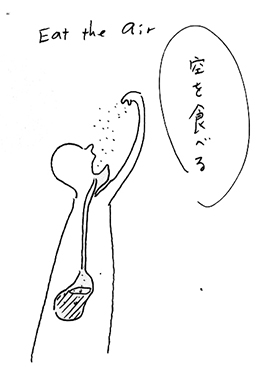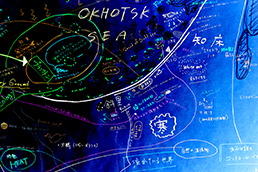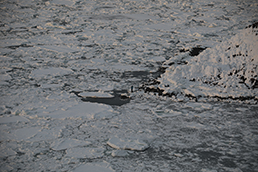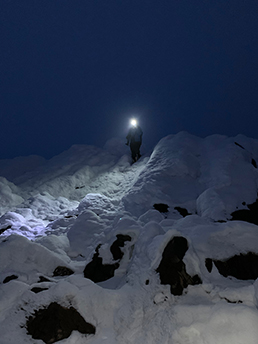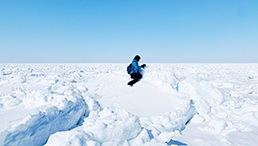eat the air
2020
Research Project, Installation Plan and video work
Sapporo International Art Festival 2020, Hokkaido, Japan
SIAF2020 Matrix: siaf2020matrix.jp
Photo&Drawing: Takehito Koganezawa
Mind Map: Yoichi Kamimura+Takehito Koganezawa
Sapporo International Art Festival 2020 is canceled due to the continuing global spread of COVID-19. New online project for showing the plans of the works by participants was launched. It runs for 58 days, starting from December 19, 2020 to February 14, 2021.
This project is a collaboration by Yoichi Kamimura and Takehito Koganezawa. They teamed up to create artwork that uses Spporo City's underground snow-melting tank, which is located on the northern side of Sapporo station, as a venue. With the help of Hokkaido University's CoSTEP(Communication in Science and Technology Education and Research Program), Kamimura has conduced field research in the town of Shari, on the Shiretoko Peninsula, and recorded the various sounds that drift ice makes since 2019. Koganezawa has worked on artworks that combined space, sounds, and light, such as "Naked Theatre" which he showed at the Kanagawa Arts Theatre in 2019. These two artists were attempting to create a new space by combining lighting and various sounds, including those of nature, and optimizing the underground snow-melting tank that collects and processes winter snow in Sapporo.
For the online program Kamimura and Koganezawa produced a video work with sound/video materials and mind map, instead of huge installation in the snow-melting tank which they had been planning.
[Statement for "eat the air"]
gEcological uniqueness \ opening the organs of the city to breathe new air.h
A huge heated pool where snow is collected and melted can befound in the underground of the bus terminal at the north exit of Sapporo Station. An invisible organ of the city was functioning there. Although it has the capacity to process 285 10-ton trucksf worth of snow in one day, it has only been in operation a few times over the past few years.
The scope of human life has been narrowed, and while we cannot do things the same way as before, we are gradually developing a new style of behavior based on new senses. The environment of this planet is now changing beyond human recognition, as with climate change and global warming. In Hokkaido, we saw pools where snow didnft melt and drift ice that shrank year after year. The COVID-19 is also an event that cannot be predicted by humans, and it comes suddenly regardless of our situation. The ecological uniqueness exists in the moment. The most primordial uniqueness for us organisms is when the atmosphere of the earth becomes unstable and fluid due to photosynthesis, an oxygen atmosphere is formed, animals begin to breathe the air in their lungs, and the place of life is shifted from the sea to the land. The oceans, which had been a place for the circulation of life until then, suddenly opened up, and a new ecosystem of life spread into the atmosphere by breathing the air.
As the oceans opened up to eat the air, giving birth to a new ecosystem, let us eat the unstable air generated by this uniqueness of our time and re-evaluate the world in which we live on the premise of our relationship with various invisible events.
Like the echoes of seals in the sea, we can perceive the distant world and live in a sense of distance from our neighbors. For a sacred ecology is full of tolerance while allowing the possibility of death coming closer.
@@@
2020
Research Project, Installation Plan and video work
Sapporo International Art Festival 2020, Hokkaido, Japan
SIAF2020 Matrix: siaf2020matrix.jp
Photo&Drawing: Takehito Koganezawa
Mind Map: Yoichi Kamimura+Takehito Koganezawa
Sapporo International Art Festival 2020 is canceled due to the continuing global spread of COVID-19. New online project for showing the plans of the works by participants was launched. It runs for 58 days, starting from December 19, 2020 to February 14, 2021.
This project is a collaboration by Yoichi Kamimura and Takehito Koganezawa. They teamed up to create artwork that uses Spporo City's underground snow-melting tank, which is located on the northern side of Sapporo station, as a venue. With the help of Hokkaido University's CoSTEP(Communication in Science and Technology Education and Research Program), Kamimura has conduced field research in the town of Shari, on the Shiretoko Peninsula, and recorded the various sounds that drift ice makes since 2019. Koganezawa has worked on artworks that combined space, sounds, and light, such as "Naked Theatre" which he showed at the Kanagawa Arts Theatre in 2019. These two artists were attempting to create a new space by combining lighting and various sounds, including those of nature, and optimizing the underground snow-melting tank that collects and processes winter snow in Sapporo.
For the online program Kamimura and Koganezawa produced a video work with sound/video materials and mind map, instead of huge installation in the snow-melting tank which they had been planning.
[Statement for "eat the air"]
gEcological uniqueness \ opening the organs of the city to breathe new air.h
A huge heated pool where snow is collected and melted can befound in the underground of the bus terminal at the north exit of Sapporo Station. An invisible organ of the city was functioning there. Although it has the capacity to process 285 10-ton trucksf worth of snow in one day, it has only been in operation a few times over the past few years.
The scope of human life has been narrowed, and while we cannot do things the same way as before, we are gradually developing a new style of behavior based on new senses. The environment of this planet is now changing beyond human recognition, as with climate change and global warming. In Hokkaido, we saw pools where snow didnft melt and drift ice that shrank year after year. The COVID-19 is also an event that cannot be predicted by humans, and it comes suddenly regardless of our situation. The ecological uniqueness exists in the moment. The most primordial uniqueness for us organisms is when the atmosphere of the earth becomes unstable and fluid due to photosynthesis, an oxygen atmosphere is formed, animals begin to breathe the air in their lungs, and the place of life is shifted from the sea to the land. The oceans, which had been a place for the circulation of life until then, suddenly opened up, and a new ecosystem of life spread into the atmosphere by breathing the air.
As the oceans opened up to eat the air, giving birth to a new ecosystem, let us eat the unstable air generated by this uniqueness of our time and re-evaluate the world in which we live on the premise of our relationship with various invisible events.
Like the echoes of seals in the sea, we can perceive the distant world and live in a sense of distance from our neighbors. For a sacred ecology is full of tolerance while allowing the possibility of death coming closer.

